East Chevington is a Northumberland Wildlife Trust reserve on the coast, about five miles south of the fishing town of Amble. It is the result of opencast mining which took place in the early eighties to early-mid nineties and is part of the Druridge Bay complex of reserves. It comprises two fresh water ponds divided by a public right of way. The Northern pond is mainly un-vegetated with two-three small islands crossing it about half way along its length with a small reed bed along the southern and south eastern edge. The Southern pond is fringed with Phragmites Reed, which took many years to become established. It now boasts a healthy population of Reed and Sedge Warblers and also Northumberland’s only breeding pair of Marsh Harriers.


Throughout the seventies to 1982, the Northumbria Ringing Group (NRG) used to ring the reed lined stream that comprised the Chevington Burn prior to open-casting. The main target species was Swallow, and a large roost occurred during late July-early August and was netted over several weekends every year. Other species were also trapped, including the counties first Two-barred Crossbill, in July 1972. Also trapped during the day, were many Sedge Warblers and several Reed Warblers, the latter a scarce bird in the county only breeding at Gosforth Park in SE Northumberland.
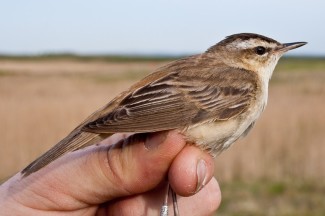
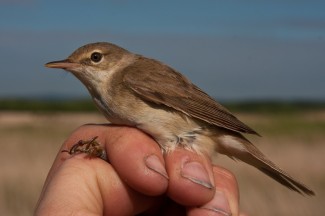
After the opencast finished and the land came into the NWT’s hands as a reserve, I was keen to see if the area was still attractive to the warblers and if the Swallow roost was still active. I got permission to ring the site in 2004 and Mike Carr and I wandered around the southernmost part of the south pond and cut four net rides through the reedbed. Since then I have closed down one of the net rides due to the water level being too high for safe use, and have extended the fourth ride. Ringing is undertaken from mid-late May and I aim to have the nets set up by about 0600 and usually finish ringing at about midday, by which time the number of birds being caught has tailed off. From late July (after the local birds have finished breeding), tape recorded lures of Reed and Sedge Warblers are used to attract birds within the reedbed to the nets. This works particularly well and up to 100+ birds can be ringed in a morning, but the usual catch from late July-early September is between 40-70 birds. Unfortunately the Swallow roost is no longer active.

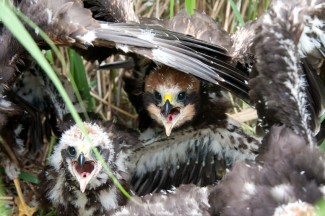
During the 11 years of ringing the site, I’ve ringed 2982 full grown birds and 20 pulli (nestlings) of 25 species (see ringing table below).
| Species | Pulli ringed | Full Grown ringed | Grand Total ringed |
| Marsh Harrier | 16 | 16 | |
| Sparrowhawk | 2 | 2 | |
| Snipe | 1 | 1 | |
| Swallow | 4 | 9 | 13 |
| Meadow Pipit | 1 | 1 | |
| Yellow Wagtail | 11 | 11 | |
| Pied Wagtail | 2 | 2 | |
| Wren | 10 | 10 | |
| Dunnock | 14 | 14 | |
| Robin | 3 | 3 | |
| White-spotted Bluethroat | 1 | 1 | |
| Whinchat | 3 | 3 | |
| Stonechat | 1 | 1 | |
| Grasshopper Warbler | 4 | 4 | |
| Reed Warbler | 803 | 803 | |
| Sedge Warbler | 1805 | 1805 | |
| Whitethroat | 21 | 21 | |
| Chiffchaff | 3 | 3 | |
| Willow Warbler | 26 | 26 | |
| Bearded Tit | 5 | 5 | |
| Blue Tit | 40 | 40 | |
| Starling | 1 | 1 | |
| Goldfinch | 2 | 2 | |
| Linnet | 13 | 13 | |
| Reed bunting | 201 | 201 |


| Year | 2004 | 2005 | 2006 | 2007 | 2008 | 2009 |
| Ringing total | 105 | 109 | 327 | 88 | 270 | 324 |
| No. of species ringed | 10 | 6 | 9 | 5 | 9 | 9 |
| Year | 2010 | 2011 | 2012 | 2013 | 2014 | |
| Ringing total | 550 | 580 | 77 | 151 | 405 | |
| No. of species ringed | 13 | 15 | 8 | 7 | 15 |
The poor ringing totals in 2007 & 2012 were mainly due to high water levels and very windy summers which limited the number of visits.
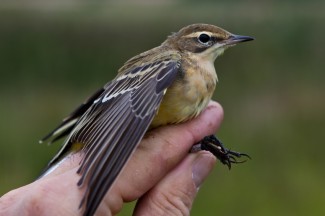
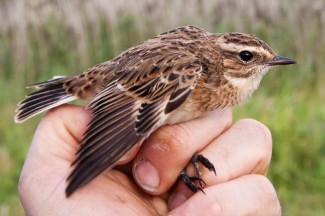
Text and images by Ian Fisher
